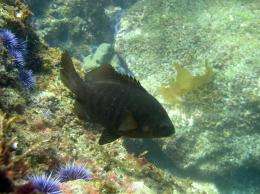Scientists capture clues to sustainability of fish populations

Thanks to studies of a fish that gives birth to live young and is not fished commercially, scientists at UC Santa Barbara have discovered that food availability is a critical limiting factor in the health of fish populations.
The scientists were able to attach numbers to this idea, based on 16 years of data. They discovered that the availability of enough food can drive up to a 10-fold increase in the per capita birthrate of fish. And, with adequate food, the young are up to 10 times more likely to survive than those without it.
This research, published this week in the Proceedings of the Royal Society B, is expected to be useful for managers involved in maintaining sustainable fisheries.
The scientists used a remarkable set of black surfperch population data –– collected from 1993 to 2008 –– to develop these statistics. Divers collected the data by monitoring a fish population off Santa Cruz Island, near Santa Barbara. Russell J. Schmitt and Sally J. Holbrook, both professors in UCSB's Department of Ecology, Evolution, and Marine Biology and UCSB's Marine Science Institute, head the team of scientists.
First author Daniel K. Okamoto, a Ph.D. student in UCSB's Department of Ecology, Evolution, and Marine Biology, explained that there has been a lack of information about how survival and birthrates are influenced by food availability, which is known to fluctuate through time. Black surfperch, found off the Pacific Coast from central Baja California northward to Fort Bragg, feed on small crustaceans and worms.
"If a management procedure has called for a certain harvest rate that is constant through time, that would be like saying we should harvest the same amount of corn through time, even though we know that corn can be influenced by things like drought," said Okamoto.
The scientists consider the black surfperch (Embiotoca jacksoni) to be a model species because it is not fished commercially, making it easier to assess the effects of food availability on fish mortality and reproduction.
A key feature of the black surfperch is the fact that this fish gives birth to live young that remain on the reef, allowing for its population to be counted accurately from year to year.
"The individual fish stay on their natal reef; they have low emigration- immigration rates, so we can actually track cohorts through time," said Okamoto. "An adult gives birth to live, capable young, instead of laying eggs. Those young stay on the reef where the adults were, which is a really nice property. We can go to a reef in a given year, survey it for adults, then go to that reef again the next year and see the young that are there and know, for the most part, that those young came from the adults that were there the year before." By contrast, most fish are dispersed into open water when they are in the larval stage.
Okamoto said that not including food availability in calculating benchmarks for species conservation may leave out a critical element in fisheries management.
Journal information: Proceedings of the Royal Society B
Provided by University of California - Santa Barbara



















